From the studies, the most feasible area on the eastern coast are at the northern part namely, extended coastal areas off Preito Diaz and Gubat. Barcelona and Bulusan have environmental conditions feasible for farming but for about 6 to 7 months of a year and in confined areas only. The environmental conditions of southern part of eastern Sorsogon such as at Santa Magdalena and Matnog were found to be not feasible due to its narrow seashore line. From the on-going studies in Sorsogon Bay, Juban with its protected bays appears to have an environmental condition most suitable for Gracilaria farming.
Geographically, the coastal area is located between 13° 02.5 lat., 124° 12'E long. from the north to 12°34.4' lat., 124°05.8' E long. south (figure 6). The northern area off Prieto Diaz has a very extended rocky reef flat flanked by coral reef parallel to the coast line. There are also a network of bays and channels within the area. This extended reef area extends down south to Barcelona through Gubat, gradually narrowing upon reaching Bulusan. From Bulusan down south to Matnog the coast line has a narrow strip parallel to either a rocky cliff or sandy beach. There are a number rivers and creeks flowing into the coastal areas. Most of the river systems are along the northern part of the coast, off Prieto Diaz and Gubat. The runoff from these rivers and creeks into the area would have either positive or negative effect on the hydrological condition. The substrate soil nature at the extended area off Prieto Diaz to Gubat and part of Barcelona can be generally considered as sandy/ muddy/ coralline with semi-clear water (visibility to approximately 3 meters during fine weather). Salinity recorded within the trial/test plots ranged between 29.0 and 36.0 ppt with the temperature from 29.0 to 32.0° C. The pH was recorded at between 6.0 and 8.0. From off Barcelona to Bulusan the substrata is flat rocky/coralline with clear water (visibility - more than 5 meter). High salinity of between 30.0 and 35.5 ppt was recorded in the area. The temperature ranged between 29.0 and 33.0 with a pH of approximately 8.0. South of Bulusan to Matnog along the narrow strip the substratum is usually sandy/rocky or sandy or rocky with clear water.
Hydrological conditions of the east coast was studied by Llana (1992). Seasonal variations in temperature and salinity of the east coast is shown in figure 7. Generally, the water temperature was high in the northern area particularly from May to July (up to 40°C). Low temperatures were recorded during the months from November to February ( from 27°C). The salinities ranged from 24.00 to 36.00 ppt along the coast. Generally the salinities off the northern coast were lower than the southern area.
The tidal amplitude at Legaspi ranged between 0.166 M (Mean Low Water) and 1.392 M (Mean High Water). Generally at the farming site locations, minimum depth during the minimum tidal cycle was observed to be approximately 0.25 M from the substrata. During the spring tide the depth observed was approximately 2.0 M. At the site localities, the currents from the open sea are of tidal in nature only. However, localized currents created by the river runoff and due to geographic nature of the bays and channels were also encountered.
Sorsogon Bay is located due west of the municipality of Gubat on the east coast of Sorsogon. It opens to the west into the Ticao Pass. Apart from the narrow channel and areas off Castilla in the north and Sablayan Island to the south, the water depth is less than 5.0 meters. Along the narrow channel near the opening the water is deeper (more than 10.0 M) (figure 8). According to the locals, the water surface area is estimated as approximatelly 20,000 ha. Generally the substrata of the bay is either muddy, sandy or muddy/sand in nature. The water was observed to be clear near the channel opening and semi-clear (muddy-visibility in certain condition to 30–100 cm only) within the bay area. The condition of the water depends upon the tidal current and the location. The water salinity also depends on the locality of rivers and creeks with freshwater runoff. The salinity varies between 18.0 and 31.0 ppt with temperature of between 27.0 and 33.0°C within the bay at most of the trial sites. The pH observed was from 6.0 to 8.0. Higher salinities were encountered near the mouth and in the mid region of the bay. Low salinities were found in small bays near rivers and creeks outlets. During raining season some areas became totally fresh (0.0 ppt). Temperature ranged between 25 and 30 °C.
Fig. 6. East Coast of Sorsogon
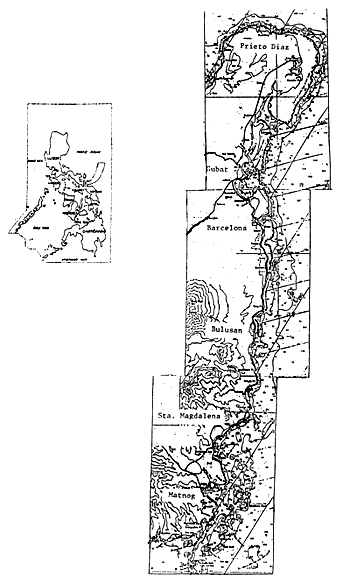
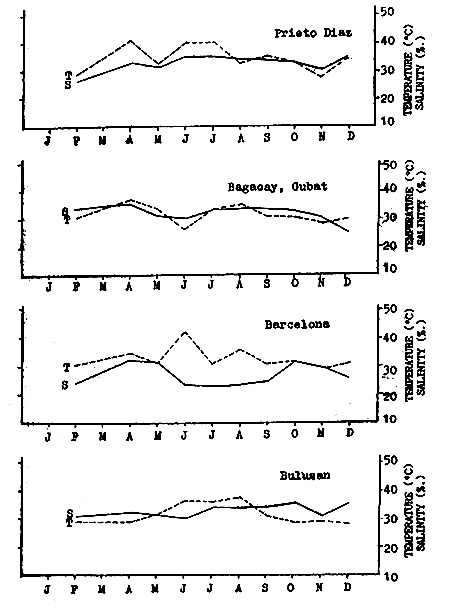
Figure 7. Seasonal salinity and temperature variation of eastern coastal shelf waters in 1990. (Llana, 1993)
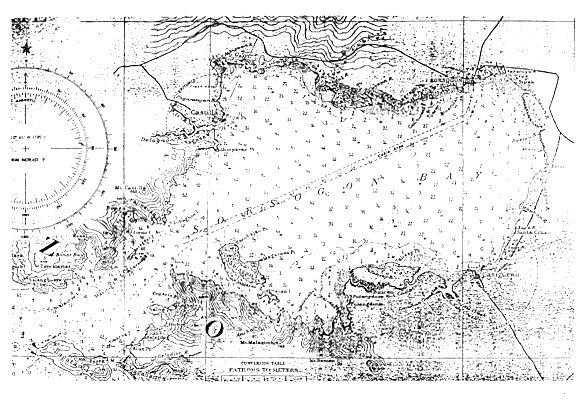
Figure 8. Sorsogon Bay chart.
The results from the farming trials are given in Figures 9 & 10 and table 1. Generally, the daily growth rate ranged from as low as 1.2 to a maximum of 16.7/day for the four species studied from monoline farming trials. Trial in fish pond had to be discontinued due to water management problem. The pond water was drained to harvest the cultured fish without prior notice for the project technicians to determine planned data. High growth (above 10 % day) had been observed during the first two weeks using seed plants weighing less than 50 grams under favorable environmental conditions during early part (March/April) of the year. The daily growth rate then declined to less than 5.0 % /day (Figures. 9 & 10). For G. firma and G. fastigiata, the weight attained after 54 days growing period with initial seed plant of 51.0 and 35.3 grams were recorded as 1,005.8 and 505.2 grams respectively. Average daily growth rate was recorded as 8.1 % for G. fastigiata and 8.7 % for G. firma. Daily growth rate of G. cylindrica was found to ranged between 4.0 and 9.1 % under favorable environmental conditions. Growth of G. tenuispititata was between 3.3 and 11.2 % within the range found with the other Gracilaria species. Slow growth of G. cylindrica observed on the test plants in Tughan, Juban (Sorsogon Bay) was probably due to environmental conditions not suitable to the species. The G. cylindrica seed plants were from Bulusan. Sorsogon which is the natural habitat of the species. The slow growth and daily % growth of G. fastigiata and G. firma observed during later part of the year (September to December) could be attributed to strong currents caused by typhoons in the area (Figure 10). Lost of seaweed plants and planted lines were common during the period. An average daily growth rate of the four species studied is given in table 1. Under optimum environmental condition a maximum daily growth rate for G. fastigiata. G. firma, G. cylindrica and G. tanuistipitata was observed to be 9.0 %, 8.7 %, 9.1 % and 11.2 % respectively.
Problems encountered, in the monoline farming trials using vegetative thalli, include grazing by fish, sediment accumulation and epiphytism. Strong wind and currents were the major cause of losses of seaweed from the lines in some open areas, especially during the typhoon period. The major non-environmental problem faced during the trials was theft of planted seaweeds.
Field culture of Gracilaria in Danajon Peef, the central Visayas by Largo, et. al. (1989) indicated that a biomass production may reach 100 times the initial stock after two months, time or a daily growth rate of not more than 5.0 % depending on the species and planting method. However, according to Large, et al. (1989) a mean daily growth rate during field experiments of Gracilaria verrucosa was recorded as 10.02% in the intertidal areas and 4.29% in ponds in Visayas. Comparatively, an average daily growth rate of Eucheuma has been recorded as 5.0%/day (Trono & Gazon-Forts. 1988). For Eucheuma, at 5% average daily growth rate with 40,000 seedlings (300 gm each) could produce 48,000 kg within two months.
Experiments in growing of Gracilaria sporelings in petri dishes and dextrose bottles using different culture media under controlled environmental conditions were conducted for 30 days by Uy. et.al. (1990). Highest growth rate and early development of newly shed carpospores grown in petri dishes were recorded in Waines Conway medium (104%/day) followed by VonStosch medium (59%/day). For the 30 day sporelings grown in dextrose bottles with continuous aeration, highest growth rate was recorded in VoSthsch (33.8%/day) followed by TMRL (11.05%/day). The present findings of faster growth at the early stage agreed with the findings of Uy, et.al. (1990) experimental results.
Recently Gracilaria species are being farmed in natural drainage canals and ponds in Panay, Western Visayas (Hurtado-Ponce, et.al., 1992). According to them, initial harvest are made 15 to 60 days after planting. High production of 7– 14 tons (dried)/ha/year are obtained from canals than in ponds (3–4 t/ha/year). It appeared that the estimated production of Gracilaria from the present trials are approximately the same as the production recorded by Hurtado-Ponce et.at (1992) on Gracilaria planted in the canal in western Visayas. In the present case G. fastigiata and G. firma attained an average plant weight of 505.2 and 1,005.5 grams in 54 days from an initial seed plant weighing 35.3 and 51.5 grams respectively. Growth and daily growth rate of the two species are shown in figures 9 and 10.
Hypothetically, based on results of the daily growth rate of between 6.0 and 11.2% for the Gracilaria species studied, with initial individual seed plant weight of approximately 100 grams a final individual weight of 400 grams can be attained, after losses due to seedling mortality and other environmental factors, after 45 to 50 days of farming period, under favorable environmental condition. From a hectare (100 plots with 102,400 seed plants-see 3.3.1) a production of 40 tons (wet) (wet to dry weight ration varies between 9:1 and 10:1) can be expected per cycle. Depending on the location of farm and environmental conditions 3 to 5 farming cycles can be managed in a year.

Figure 9. Growth and daily growth rate of G. fastigiata during March/April 1992 at Bacagay, Gubat.
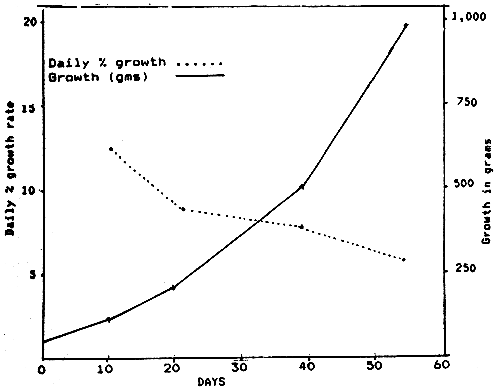
Figure 10. Growth and daily growth rate of G. firma during March/ April 1992 at Bacagay, Gubat.
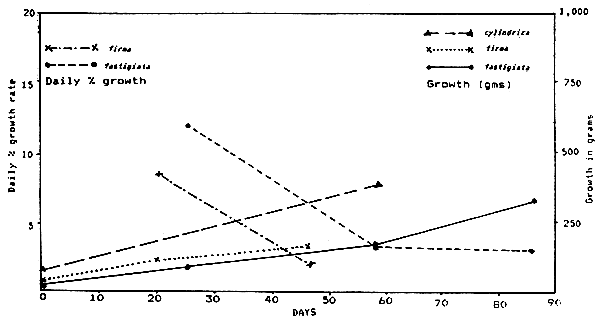
Figure 11. Growth and growth rate of (i) G. fastigiata and G. firma during September-December 1992 at Bacagay, Gubat; and (ii) G. cylindrica during December 1992/January 1993 at Barcelona.
| Farm | Species | Period Month/yr | Days | Method | Growth Daily % | ENVIRONMENT (Range) | ||
| Sal. | Temp. | pH | ||||||
| EAST COAST | ||||||||
| Ca/PD | fastigiata | 09–12/92 | 87 | FB | 3.3 (L) | 34/35 | 29/30 | |
| 6.1 (C) | ||||||||
| Sa/PD | fastigiata | 01-/93 | 8 | FB | 6.7 (L) | 33/34 | 28 | |
| 9.0 (C) | ||||||||
| Ba/GT | fastigiata | 03–04/92 | 54 | FB | 8.1 | 29/36 | 29/32 | |
| Ba/GT | firma | 03–04/92 | 54 | FB | 8.7 | 29/36 | 29/32 | |
| Ba/GT | firma | 10–11/92 | 47 | FB | 2.7 (L) | 33/34 | 30/32 | |
| 5.0 (C) | ||||||||
| Ba/GT | tenuistip. | 01-/93 | FB | 33 | 29 | |||
| Ba/GT | tenuistip. | 01-93 | FB | 36 | 28 | |||
| Mp/BAR | cylindrica | 07–08/92 | 36 | FR | 3.2 | 30–34 | 29/33 | 6–8 |
| Mp/BAR | cylindrica | 10–11/92 | 21 | FB | 3.6 | 30 | 29/30 | |
| Td/BAR | tenuistip. | 11-/92 | P | 30 | 29/30 | 6 | ||
| Bar/BAR | cylindrica | 12/92–02/93 | 58 | FB | 9.1 (L) | 34/35 | 27/30 | 8 |
| 8.5 (C) | ||||||||
| Mb/BUL | cylindrica | 09–10/92 | 28 | FR | 2.1 (L) | 30/34 | 29/30 | |
| 2.6 (C) | ||||||||
| SORSOGON BAY | ||||||||
| Da/CAS | tenuistip. | 10-/92 | 26 | FB | 6.2 | 30/31 | 29 | 6.2 |
| Tg/JB | tenuistip. | 06–07/92 | 8 | FR | 5.2 | ? | ? | ? |
| Tg/JB | tenuistip. | 06–07/92 | 8 | FB | 3.3 | 30 | 29 | 5.9 |
| Tg/JB | cylindrica | 01-/93 | 14 | FB | 1.2 (L) | 18/25 | 28/29 | 6/8.5 |
| 0.3 (C) | ||||||||
| Em/JB | tenuistip. | 10–11/92 | FR | 0–10 | 25 | 6 | ||
| Bd/MAG | tenuistip. | 07–08/92 | 15 | FR | 11.2 (L) | 29/30 | 29.4 | 6.4] |
| 7.3 (C) | ||||||||
Ca/PD = Carayat, Preto Diaz
Sa/PD = Sabang, Preto Diez
Ba/GT = Bagacay, Gubat
Mp/BAR = MApapac, Barcelona
Td/BAR = Tagdon, Barcelona
Mb/BUL = Mabuhay, Bulusan
Da/BUL = Dancalan, Bulusan
Da/CAS = Dancalan, Castilla
Tg/JB = Tughan, Juban
Em/JB = Embarca, Juban
Bd/MAG = Banacud, Magallanes
(L) = Sample plant from line
(C) = Control plant
FB = Fixed bottom
FR = Floating raft
P = Pond